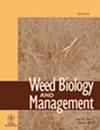下载PDF
{"title":"Effect of simulated herbivory on bellyache bush (Jatropha gossypiifoliaL.) growth and implications for biological control","authors":"N. Kumaran, C. Lockett, K. Dhileepan","doi":"10.1111/WBM.12159","DOIUrl":null,"url":null,"abstract":"Understanding the ability of invasive plants to compensate for herbivory damage is crucial for their management, but this has been poorly studied in weed biological control. Bellyache bush (Jatropha gossypiifolia L.) is an invasive weed and a target for biological control in Australia. To understand the response of bellyache bush to herbivory, we simulated herbivory damage, under field conditions, at a site in north Queensland. Two size classes, that is, seedlings and mature plants were subjected to either defoliation, shoot damage or a combination of both, and the damage was inflicted once, twice or thrice at 6–7 weeks interval. All herbivory types significantly reduced growth and biomass when herbivory was inflicted twice or thrice, whereas the single application had limited impact. Shoot damage alone and defoliation + shoot damage had a greater negative impact than defoliation treatment on plant height, basal stem diameter, the number of leaves, root length and the number of shoot tips produced while increasing the number of dead shoot tips. Defoliation alone and defoliation + shoot damage had a greater negative impact on the number of flowers and fruit pods produced than shoot damage. The greater negative effects noticed when herbivory was inflicted twice or thrice suggest that multivoltine biological control agents that can inflict shoot damage and defoliation should be sought for the biological control of bellyache bush. © 2018 Weed Science Society of Japan","PeriodicalId":23536,"journal":{"name":"Weed Biology and Management","volume":" ","pages":""},"PeriodicalIF":1.3000,"publicationDate":"2018-10-28","publicationTypes":"Journal Article","fieldsOfStudy":null,"isOpenAccess":false,"openAccessPdf":"https://sci-hub-pdf.com/10.1111/WBM.12159","citationCount":"4","resultStr":null,"platform":"Semanticscholar","paperid":null,"PeriodicalName":"Weed Biology and Management","FirstCategoryId":"97","ListUrlMain":"https://doi.org/10.1111/WBM.12159","RegionNum":4,"RegionCategory":"农林科学","ArticlePicture":[],"TitleCN":null,"AbstractTextCN":null,"PMCID":null,"EPubDate":"","PubModel":"","JCR":"Q3","JCRName":"AGRONOMY","Score":null,"Total":0}
引用次数: 4
引用
批量引用
模拟草食对麻疯树(Jatropha gossypifolial .)生长的影响及其生物防治意义
了解入侵植物补偿草食性损害的能力对其管理至关重要,但这在杂草生物控制中的研究很少。Bellyache bush(Jatropha gossypolia L.)是一种入侵杂草,也是澳大利亚生物防治的目标。为了了解腹痛灌木对食草动物的反应,我们在昆士兰北部的一个地点模拟了野外条件下的食草动物损伤。两种大小的类别,即幼苗和成熟植物受到落叶、枝条损伤或两者结合的伤害,每隔6-7周造成一次、两次或三次损伤。当两次或三次施加草食性时,所有草食性类型都显著降低了生长和生物量,而单一施用的影响有限。单茎损伤和落叶+茎损伤对株高、基茎直径、叶片数量、根长和茎尖数量的负面影响大于落叶处理,同时增加了死茎尖数量。单独落叶和落叶+地上部损伤对花和果荚产量的负面影响大于地上部损伤。当两次或三次实施草食性行为时,注意到更大的负面影响,这表明应该寻找能够造成芽损伤和落叶的多电压生物控制剂来进行腹痛灌木的生物控制。©2018日本杂草科学学会
本文章由计算机程序翻译,如有差异,请以英文原文为准。


